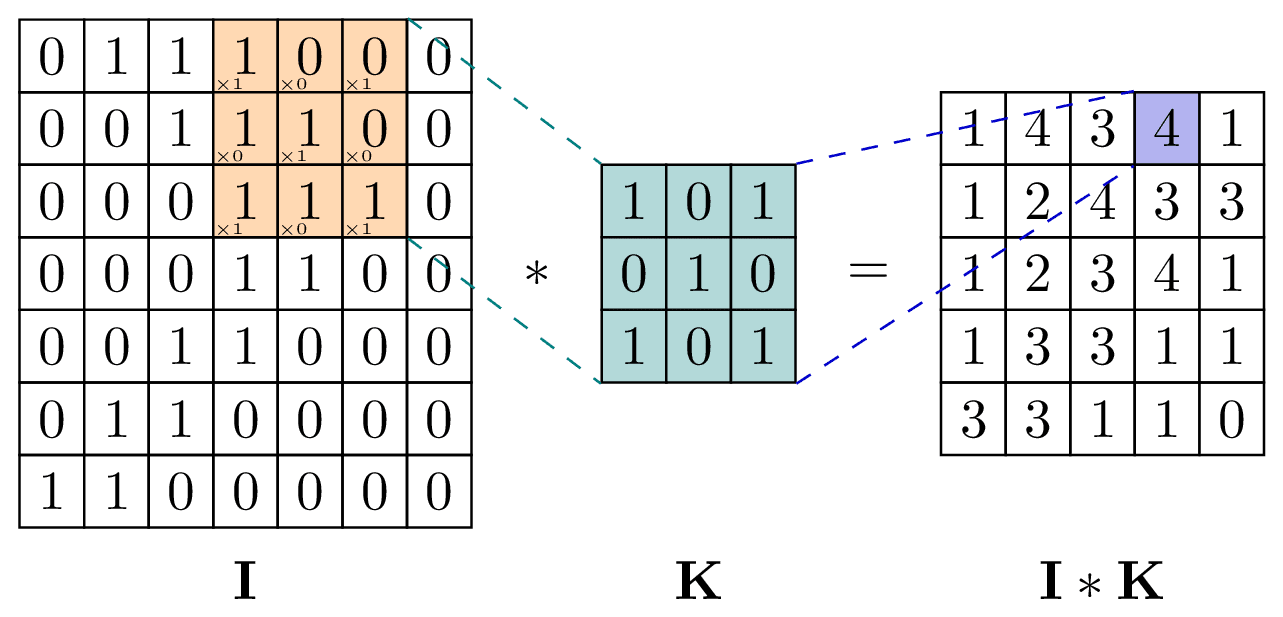Conv2d
Creator: Petar Veličković (original)
Tags
A two-dimensional convolution operator slides the kernel matrix across the target image and records elementwise products. Makes heavy use of the matrix environment in TikZ.

Edit
Download
Code
conv2d.tex (56 lines)
\documentclass[tikz]{standalone}
\usetikzlibrary{matrix, positioning}
\begin{document}
\begin{tikzpicture}[
2d-arr/.style={matrix of nodes, row sep=-\pgflinewidth, column sep=-\pgflinewidth, nodes={draw}}
]
\matrix (mtr) [2d-arr] {
0 & 1 & 1 & |[fill=orange!30]| 1 & |[fill=orange!30]| 0 & |[fill=orange!30]| 0 & 0\\
0 & 0 & 1 & |[fill=orange!30]| 1 & |[fill=orange!30]| 1 & |[fill=orange!30]| 0 & 0\\
0 & 0 & 0 & |[fill=orange!30]| 1 & |[fill=orange!30]| 1 & |[fill=orange!30]| 1 & 0\\
0 & 0 & 0 & 1 & 1 & 0 & 0\\
0 & 0 & 1 & 1 & 0 & 0 & 0\\
0 & 1 & 1 & 0 & 0 & 0 & 0\\
1 & 1 & 0 & 0 & 0 & 0 & 0\\
};
\node[below=of mtr-5-4] {$\mathbf I$};
\node[right=0.2em of mtr] (str) {$*$};
\matrix (K) [2d-arr, right=0.2em of str, nodes={draw, fill=teal!30}] {
1 & 0 & 1 \\
0 & 1 & 0 \\
1 & 0 & 1 \\
};
\node[below=of K-3-2] {$\mathbf K$};
\node[right=0.2em of K] (eq) {$=$};
\matrix (ret) [2d-arr, right=0.2em of eq] {
1 & 4 & 3 & |[fill=blue!80!black!30]| 4 & 1\\
1 & 2 & 4 & 3 & 3\\
1 & 2 & 3 & 4 & 1\\
1 & 3 & 3 & 1 & 1\\
3 & 3 & 1 & 1 & 0\\
};
\node[below=of ret-4-3] {$\mathbf{I * K}$};
\draw[dashed, teal] (mtr-1-6.north east) -- (K-1-1.north west);
\draw[dashed, teal] (mtr-3-6.south east) -- (K-3-1.south west);
\draw[dashed, blue!80!black] (K-1-3.north east) -- (ret-1-4.north west);
\draw[dashed, blue!80!black] (K-3-3.south east) -- (ret-1-4.south west);
\foreach \i in {1,2,3} {
\foreach \j in {4,5,6} {
\node[font=\tiny, scale=0.6, shift={(-1.2ex,-2ex)}] at (mtr-\i-\j) {$\times \pgfmathparse{int(mod(\i+\j,2))}\pgfmathresult$};
}
}
\end{tikzpicture}
\end{document}